Sir John Monash, Personal Files Book 5, 6 May - 16 May 1915, Part 8
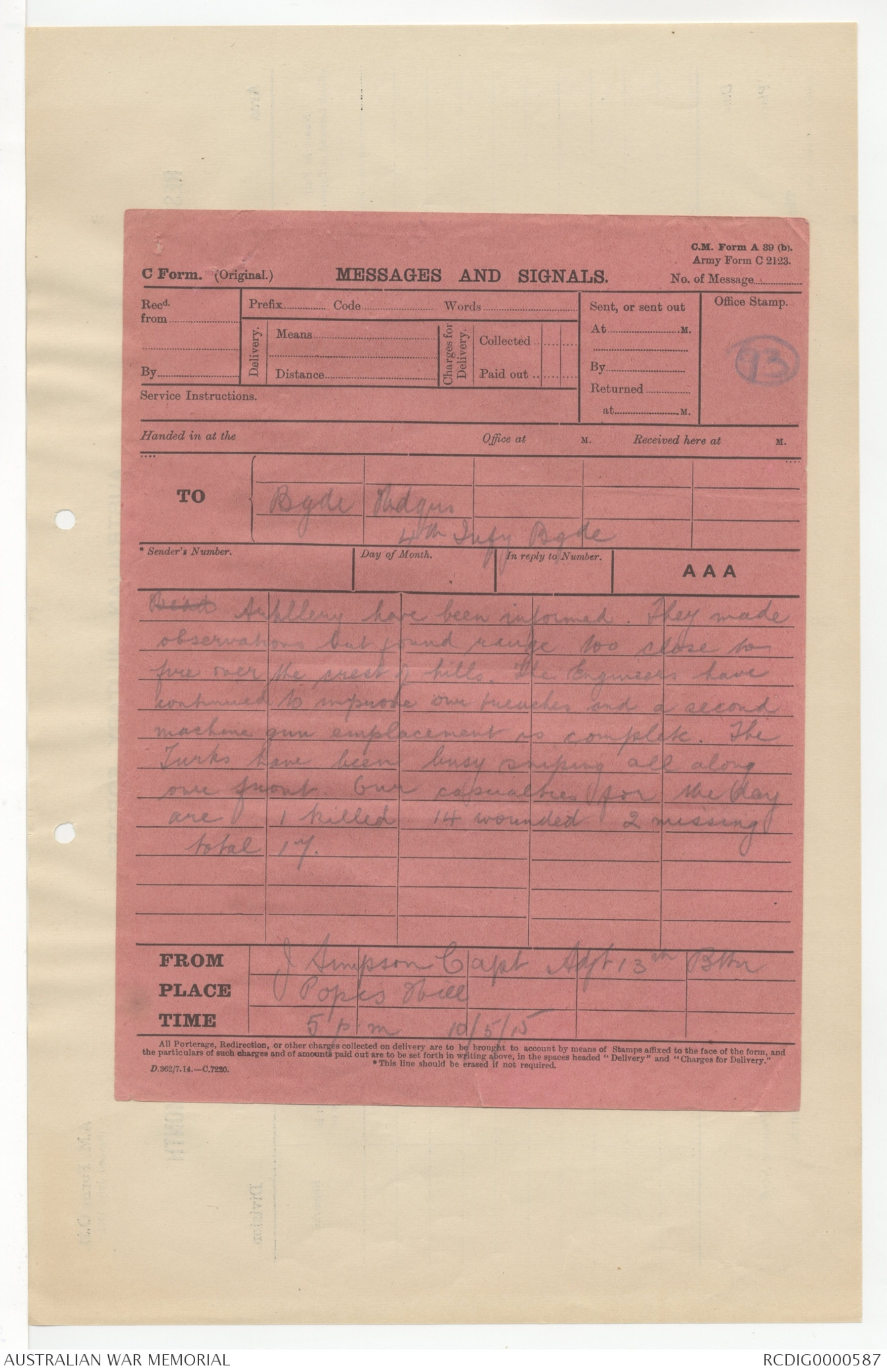
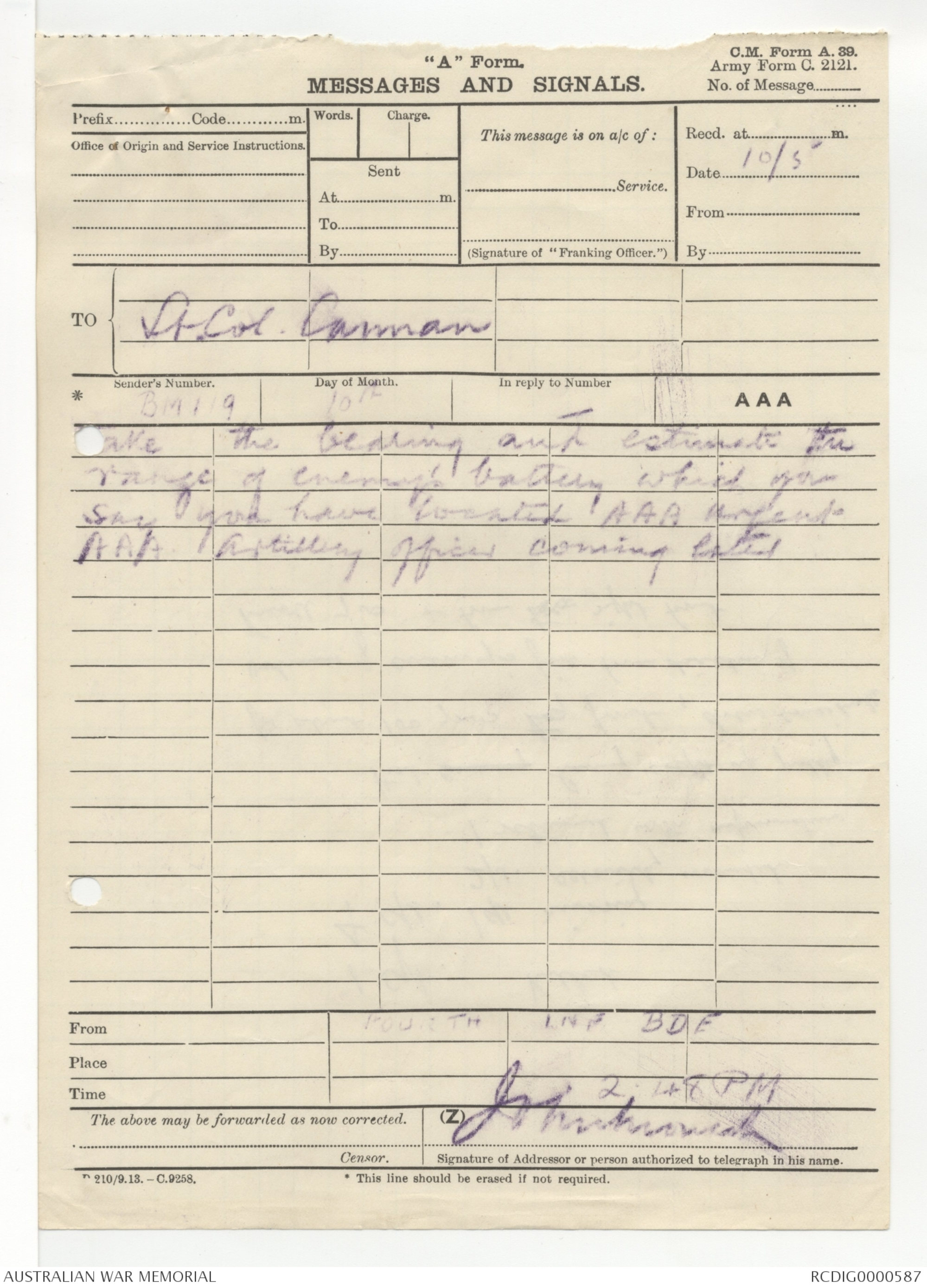
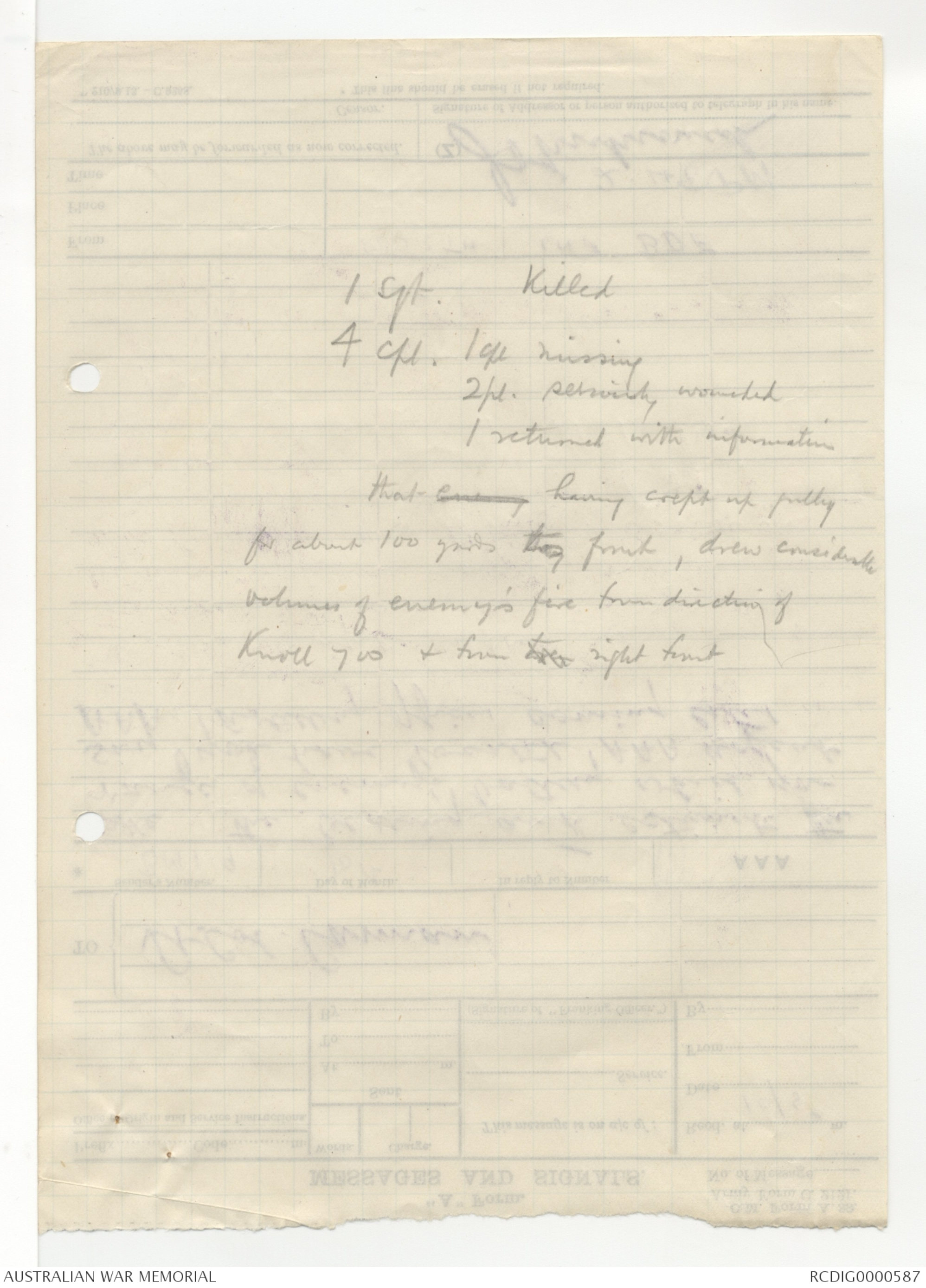
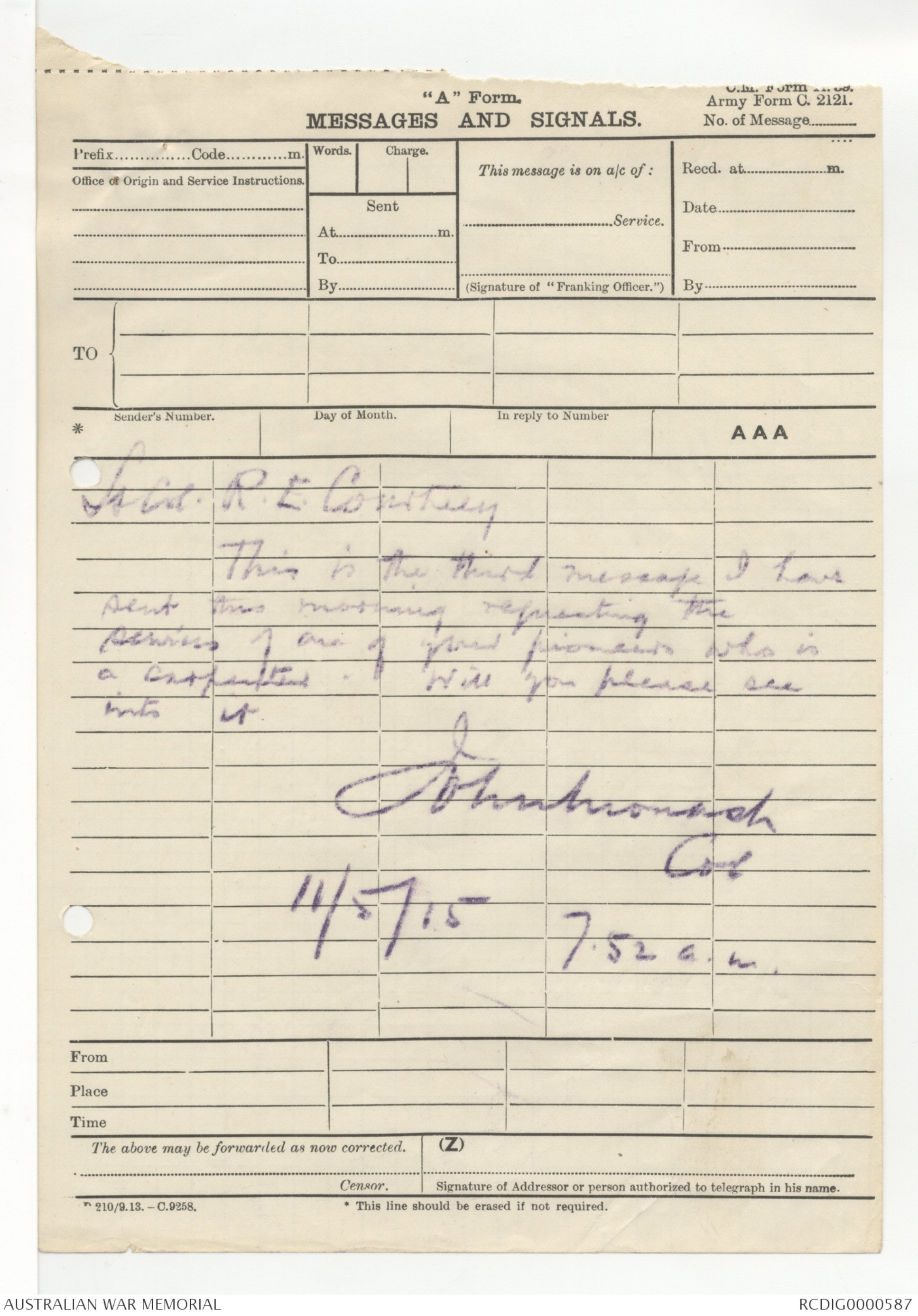
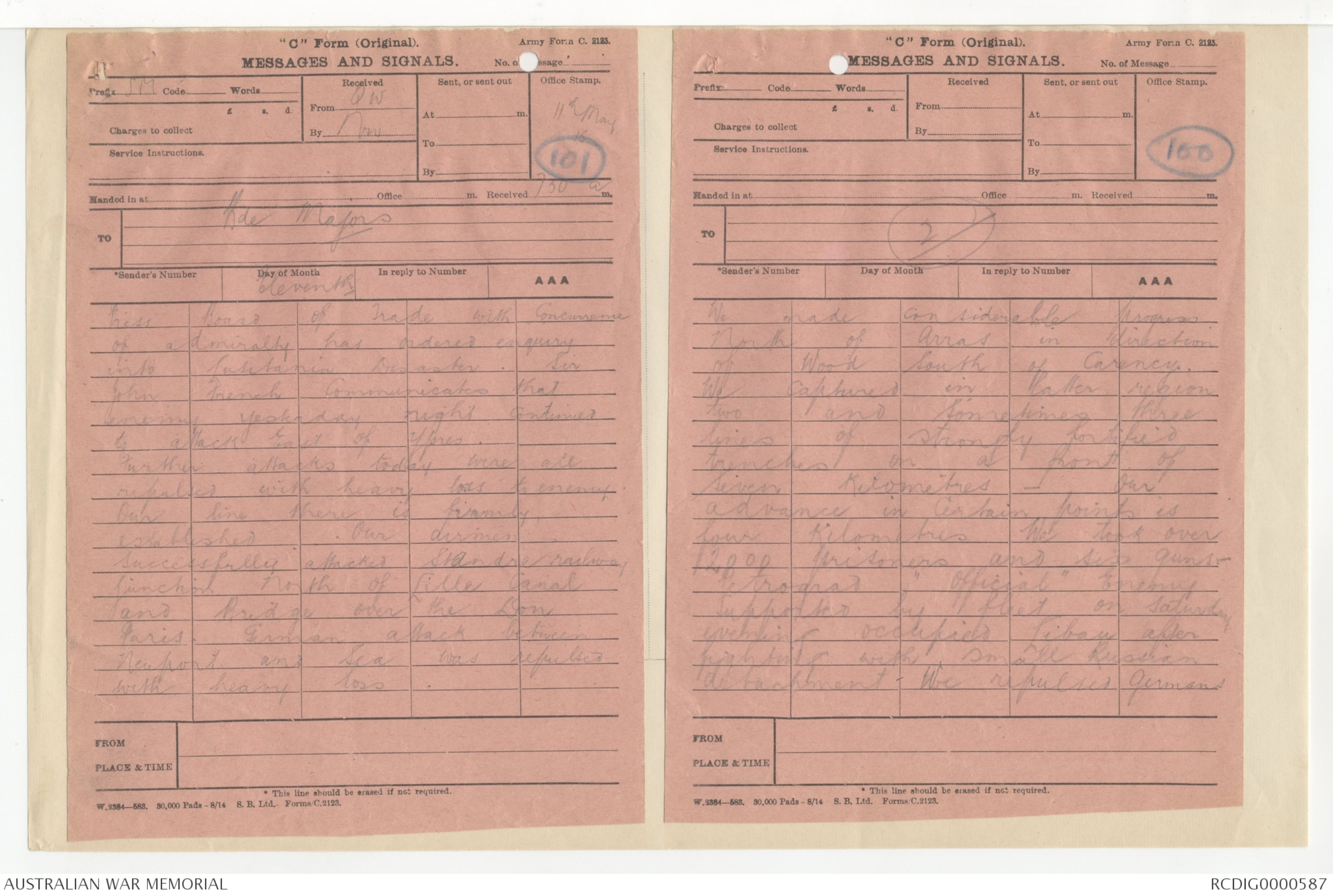
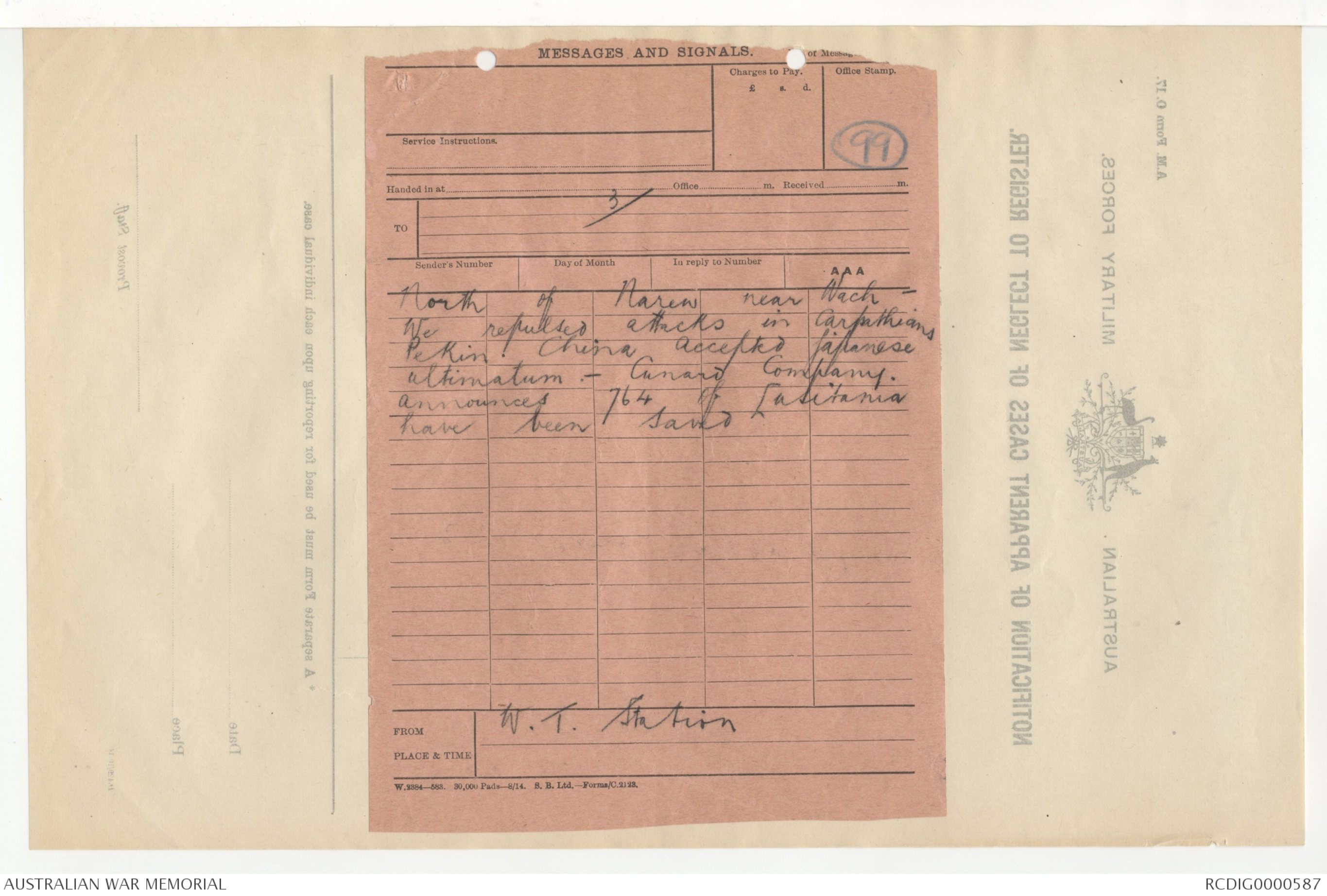
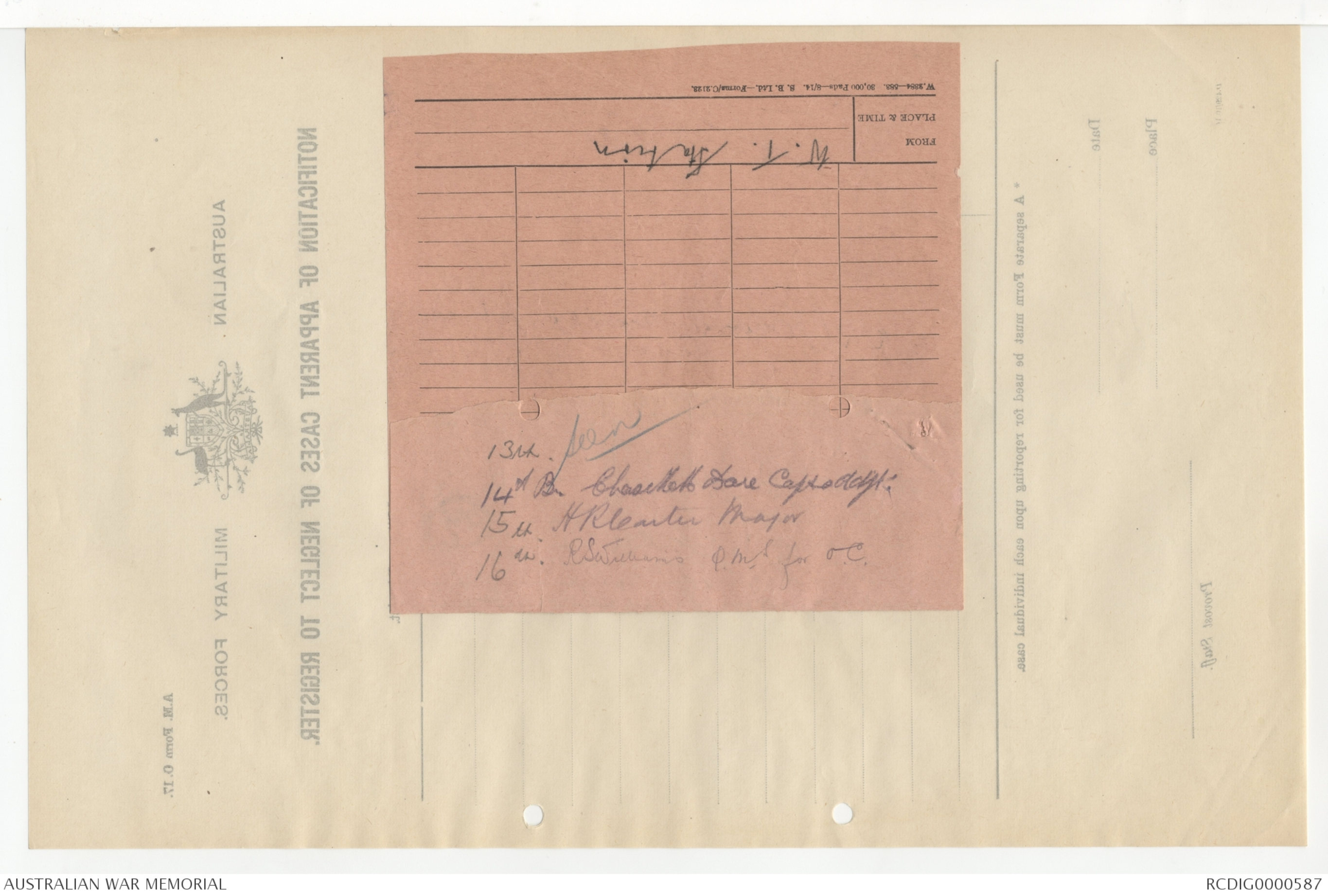
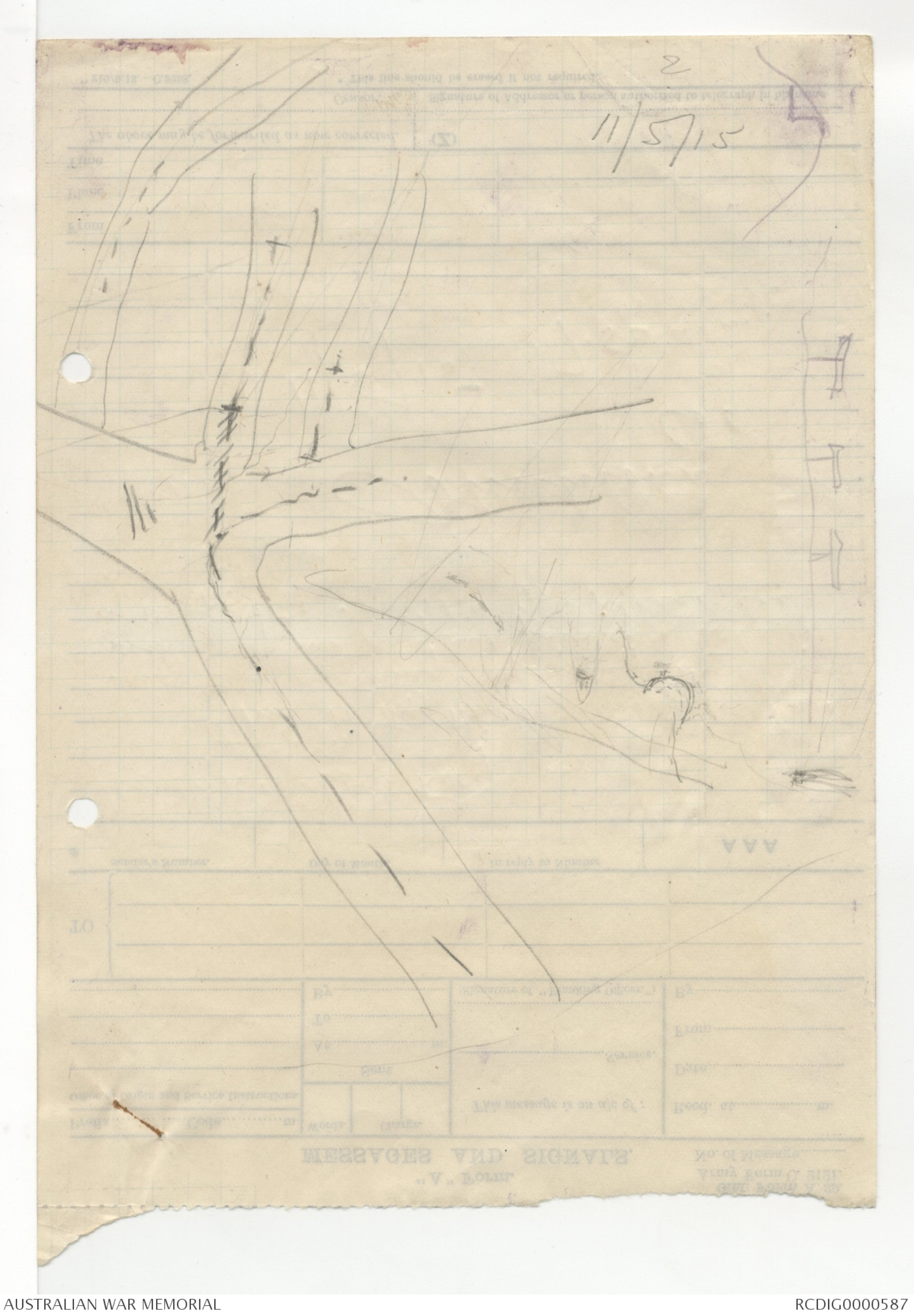
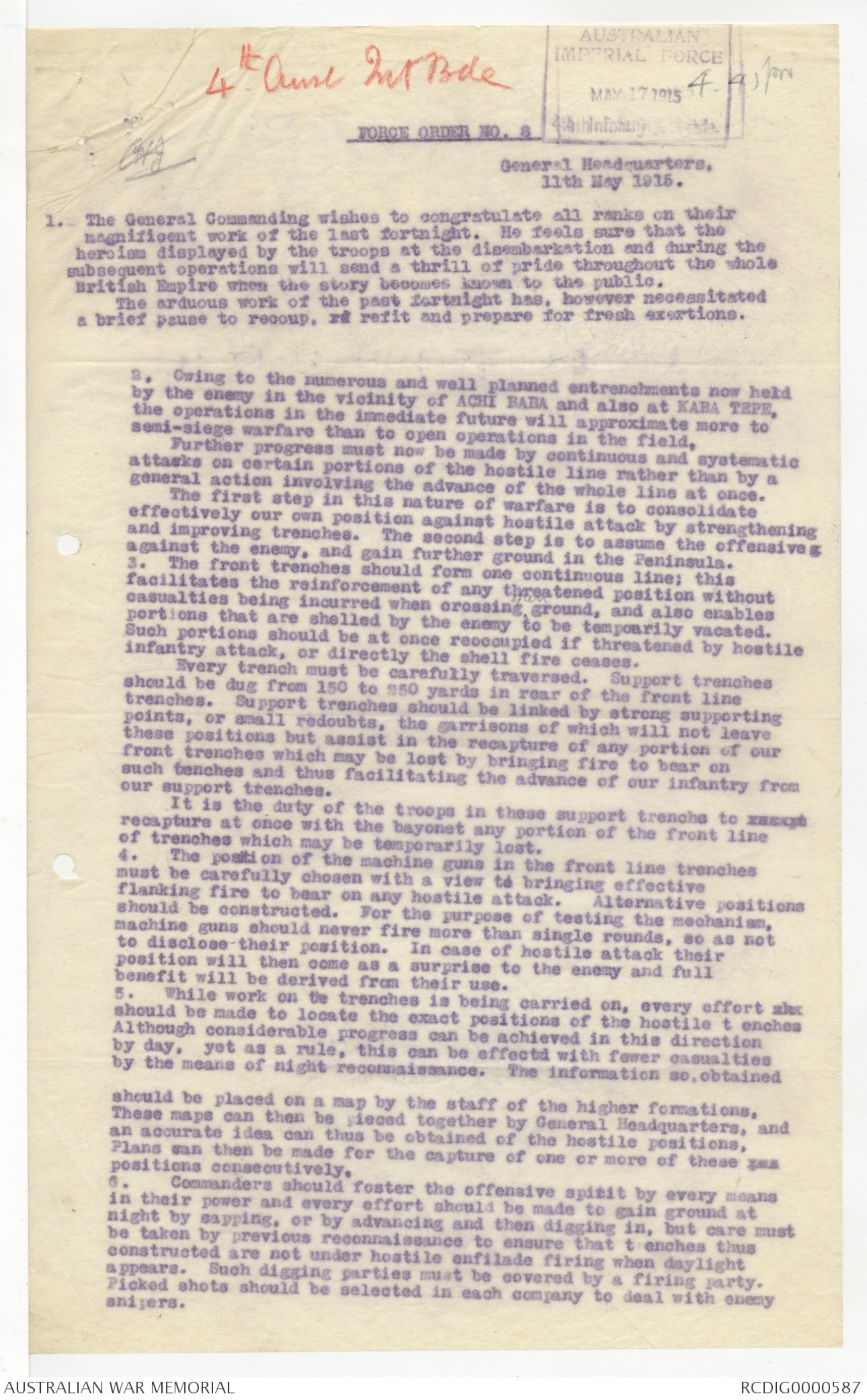
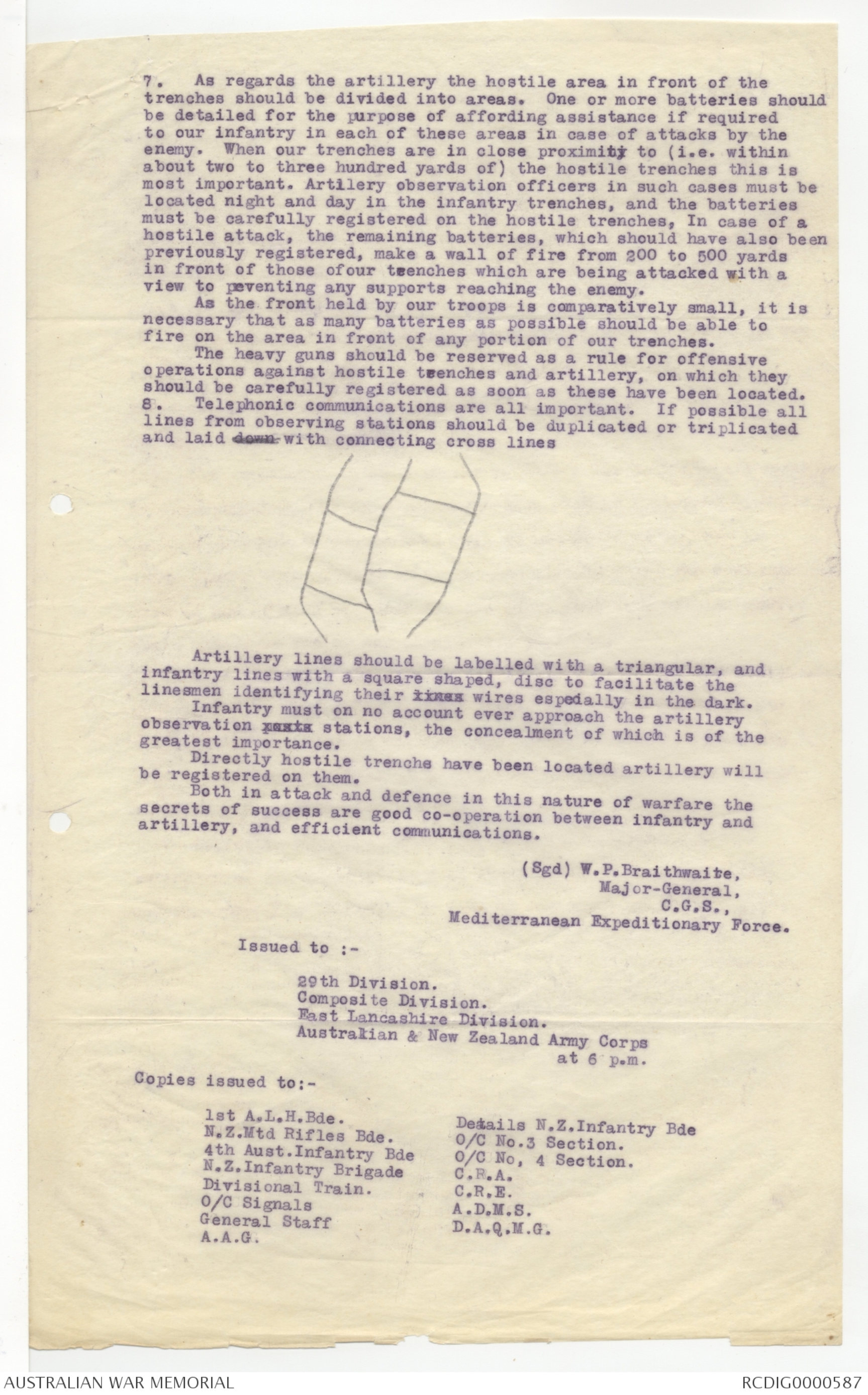
(93)
T0 Bgde Hdqrs
4th Infy Bgde
Read Artillery have been informed. They made
observations but found range too close to
fire over the crest of hills. The Engineers have
continued to improve our trenches and a second
machine gun emplacement is complete. The
Turks have been busy sniping all along
our front. Gun casualties for the day
are 1 killed 14 wounded 2 missing
total 17.
FROM J Simpson Capt Adjt 13th Bttn
PLACE Popes Hill
TIME 5 p.m 10/5/15
Date 10/5
TO Lt. Col. Cannan
*Sender's Number Day of Month
BM119 10th
Take the bearing and estimate the
range of enemy's battery which you
say you have located AAA Report
AAA Artillery officer coming later
From FOURTH INF BDE
Time 2.48 PM
John Monash
1 Sgt. Killed
4 Cpl. 1 cpl missing
2 pt. seriously wounded
1 returned with information
that counting having crept up gully
for about 100 yards to front, drew considerable
volumes of enemy's fire from direction of
Knoll 710 & from their right front.
Lt. Col. R. E. Courtney
This is the third message I have
sent this morning requesting the
services of one of your pioneers who is
a carpenter. Will you please see
into it.
John Monash
Col
11/5/15 7.52 a.m.
Prefix SM
Received From QW
By NW
11th May
(101)
Received 7.30 am.
TO Bde Majors
Day of Month eleventh
hiss Board of Trade with Concurrence
of admiralty has ordered enquiry
into Lusitania Disaster. Sir
John French Communicates that
enemy yesterday night continued
to attack East of Ypres.
Further attacks today were all
repulsed with heavy loss to enemy.
Our line there is firmly
established. Our armies
successfully attacked St Andre railway
junction North of Lille Canal
and Bridge over the Lyon
Paris. German attack between
Neuport and Sea was repulsed
with heavy loss.
(100)
TO 2
We made considerable progress
North of Arras in direction
of Wood South of Carency.
We captured in latter region
two and sometimes three
lines of strongly fortified
trenches on a front of
seven kilometres - Our
advance in Certain points is
four kilometres. We took over
2000 prisoners and six guns -
Petrograd "Official" Enemy
Supported by fleet on Saturday
evening occupied Libau after
fighting with small Russian
detachment - We repulsed Germans
(99)
TO 3
North of Narew near Wach -
We repulsed attacks in Carpathians
Pekin. China accepted Japanese
ultimatum - Cunard Company.
announces 764 of Lusitania
have been saved
FROM W. T. Station
FROM W. T. Station
13th Seen
14th Bn ChaseMM Dare Capts Adjt.
15th. HRCarter Major
16th. RSWilliams Q. Ms for O.C.
11/5/15
AUSTRALIAN
IMPERIAL FORCE
MAY 17 1915 4.45 pm
4th Infantry Brigade
4th. Aust Int Bde
[* CHJ] FORCE ORDER NO. 8 Recd May 17 1915 4.41 pm
General Headquarters,
11th May 1915.
1. The General Commanding wishes to congratulate all ranks on their magnificent work of the last fortnight. He feels sure that the heroism displayed by the troops at the disembarkation and during the subsequent operations will send a thrill of pride throughout the whole British Empire when the story becomes known to the public.
The arduous work of the past fortnight has, however necessitated a brief pause to recoup, rf refit and prepare for fresh exertions.
2. Owing to the numerous and well planned entrenchments now held by the enemy in the vicinity of ACHI BABA and also at KABA TEPE, the operations in the immediate future will approximate more to semi-siege warfare than to open operations in the field, Further progress must now be made by continuous and systematic attacks on certain portions of the hostile line rather than by a general action involving the advance of the whole line at once.
The first step in this nature of warfare is to consolidate
effectively our own position against hostile attack by strengthening and improving trenches. The second step is to assume the offensive g against the enemy, and gain further ground in the Peninsula.
3. The front trenches should form one continuous line; this
facilitates the reinforcement of any threatened position without casualties being incurred when crossing open ground, and also enables portions that are shelled by the enemy to be temporarily vacated.
Such portions should be at once reoccupied if threatened by hostile infantry attack, or directly the shell fire ceases.
Every trench must be carefully traversed. Support trenches
should be dug from 150 to 350 yards in rear of the front line
trenches. Support trenches should be linked by strong supporting points, or small redoubts, the garrisons of which will not leave these positions but assist in the recapture of any portion of our front trenches which may be lost by bringing fire to bear on such trenches and thus facilitating the advance of our infantry from our support trenches.
It is the duty of the troops in these support trenchs to recapt
recapture at once with the bayonet any portion of the front line of trenches which may be temporarily lost.
4. The position of the machine guns in the front line trenches
must be carefully chosen with a view to bringing effective
flanking fire to bear on any hostile attack. Alternative positions should be constructed. For the purpose of testing the mechanism, machine guns should never fire more than single rounds, so as not to disclose their position. In case of hostile attack their position will then come as a surprise to the enemy and full benefit will be derived from their use.
5. While work on the trenches is being carried on, every effort xxx should be made to locate the exact positions of the hostile t enches
Although considerable progress can be achieved in this direction by day, yet as a rule, this can be effected with fewer casualties by the means of night reconnaissance. The information so, obtained should be placed on a map by the staff of the higher formations, These maps can then be pieced together by General Headquarters, and
an accurate idea can thus be obtained of the hostile positions, Plans can then be made for the capture of one or more of these xxx positions consecutively.
6. Commanders should foster the offensive spirit by every means in their power and every effort should be made to gain ground at night by sapping, or by advancing and then digging in, but care must be taken by previous reconnaissance to ensure that t enches thus
constructed are not under hostile enfilade firing when daylight appears. Such digging parties must be covered by a firing party. Picked shots should be selected in each company to deal with enemy snipers.
7. As regards the artillery the hostile area in front of the
trenches should be divided into areas. One or more batteries should be detailed for the purpose of affording assistance if required to our infantry in each of these areas in case of attacks by the enemy. When our trenches are in close proximity to (i.e. within about two to three hundred yards of) the hostile trenches this is most important. Artilery observation officers in such cases must be
located night and day in the infantry trenches, and the batteries must be carefully registered on the hostile trenches, In case of a hostile attack, the remaining batteries, which should have also been previously registered, make a wall of fire from 200 to 500 yards in front of those of our trenches which are being attacked with a view to preventing any supports reaching the enemy. As the front held by our troops is comparatively small, it is necessary that as many batteries as possible should be able to fire on the area in front of any portion of our trenches.
The heavy guns should be reserved as a rule for offensive operations against hostile trenches and artillery, on which they should be carefully registered as soon as these have been located.
8. Telephonic communications are all important. 1f possible all lines from observing stations should be duplicated or triplicated and laid down with connecting cross lines
Artillery lines should be labelled with a triangular, and
infantry lines with a square shaped, disc to facilitate the
linesmen identifying their lines wires especially in the dark.
Infantry must on no account ever approach the artillery
observation posts stations, the concealment of which is of the
greatest importance.
Directly hostile trenchs have been located artillery will
be registered on them.
Both in attack and defence in this nature of warfare the
secrets of success are good co-operation between infantry and artillery, and efficient communications.
(Sgd) W.P. Braithwaite,
Major-General,
C.G.S.
Mediterranean Expeditionary Force.
Issued to :-
29th Division.
Composite Division.
East Lancashire Division.
Australian & New Zealand Army Corps
at 6 p.m.
Copies issued to:-
1st A.L.H.Bde Details N.Z. Infantry Bde
N.Z.Mtd Rifles Bde. O/C No.3 Section.
4th Aust. Infantry Bde O/C No, 4 Section.
N.Z. Infantry Brigade C.R.A.
Divisional Train. C.R.E.
O/C Signals A.D.M.S.
General Staff D.A.Q.M.G.
A.A.G.
 Jacqueline Kennedy
Jacqueline KennedyThis transcription item is now locked to you for editing. To release the lock either Save your changes or Cancel.
This lock will be automatically released after 60 minutes of inactivity.